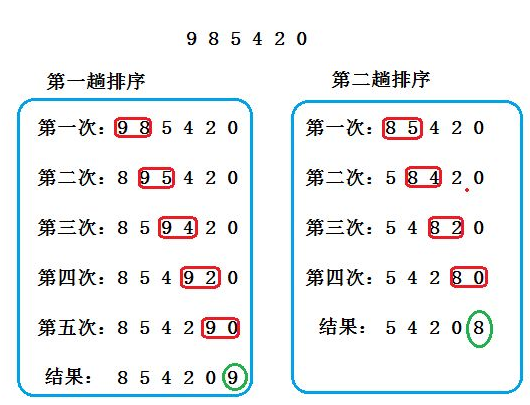冒泡排序、插入排序、快速排序
例一:冒泡排序


public class BubbleSort { /* * 冒泡排序 * * 参数说明: * a -- 待排序的数组 * n -- 数组的长度 */ public static void bubbleSort1(int[] a, int n) { int i,j; for (i=n-1; i>0; i--) { // 将a[0...i]中最大的数据放在末尾 for (j=0; j<i; j++) { if (a[j] > a[j+1]) { // 交换a[j]和a[j+1] int tmp = a[j]; a[j] = a[j+1]; a[j+1] = tmp; } } } } /* * 冒泡排序(改进版) * * 参数说明: * a -- 待排序的数组 * n -- 数组的长度 */ public static void bubbleSort2(int[] a, int n) { int i,j; int flag; // 标记 for (i=n-1; i>0; i--) { flag = 0; // 初始化标记为0 // 将a[0...i]中最大的数据放在末尾 for (j=0; j<i; j++) { if (a[j] > a[j+1]) { // 交换a[j]和a[j+1] int tmp = a[j]; a[j] = a[j+1]; a[j+1] = tmp; flag = 1; // 若发生交换,则设标记为1 } } if (flag==0) break; // 若没发生交换,则说明数列已有序。 } } public static void main(String[] args) { int i; int[] a = {9,8,5,4,2,0}; System.out.printf("before sort:"); for (i=0; i<a.length; i++) System.out.printf("%d ", a[i]); System.out.printf("\n"); bubbleSort1(a, a.length); // bubbleSort2(a, a.length); System.out.printf("after sort:"); for (i=0; i<a.length; i++) System.out.printf("%d ", a[i]); System.out.printf("\n"); } }
例二:1、插入排序法(随机数)


import java.util.Random; public class InsertSort { public void insertSort(int[] list) { // 打印第一个元素 System.out.format("i = %d:\t", 0); printPart(list, 0, 0); // 第1个数肯定是有序的,从第2个数开始遍历,依次插入有序序列 for (int i = 1; i < list.length; i++) { int j = 0; int temp = list[i]; // 取出第i个数,和前i-1个数比较后,插入合适位置 // 因为前i-1个数都是从小到大的有序序列,所以只要当前比较的数(list[j])比temp大,就把这个数后移一位 for (j = i - 1; j >= 0 && temp < list[j]; j--) { list[j + 1] = list[j]; } list[j + 1] = temp; System.out.format("i = %d:\t", i); printPart(list, 0, i); } } // 打印序列 public void printPart(int[] list, int begin, int end) { for (int i = 0; i < begin; i++) { System.out.print("\t"); } for (int i = begin; i <= end; i++) { System.out.print(list[i] + "\t"); } System.out.println(); } public static void main(String[] args) { // 初始化一个随机序列 final int MAX_SIZE = 10; int[] array = new int[MAX_SIZE]; Random random = new Random(); for (int i = 0; i < MAX_SIZE; i++) { array[i] = random.nextInt(MAX_SIZE); } // 调用冒泡排序方法 InsertSort insert = new InsertSort(); System.out.print("排序前:\t"); insert.printPart(array, 0, array.length - 1); insert.insertSort(array); System.out.print("排序后:\t"); insert.printPart(array, 0, array.length - 1); } }
2、固定数组

public class InsertSort { /* * 直接插入排序 * * 参数说明: * a -- 待排序的数组 * n -- 数组的长度 */ public static void insertSort(int[] a, int n) { int i, j, k; for (i = 1; i < n; i++) { //为a[i]在前面的a[0...i-1]有序区间中找一个合适的位置 for (j = i - 1; j >= 0; j--) if (a[j] < a[i]) break; //如找到了一个合适的位置 if (j != i - 1) { //将比a[i]大的数据向后移 int temp = a[i]; for (k = i - 1; k > j; k--) a[k + 1] = a[k]; //将a[i]放到正确位置上 a[k + 1] = temp; } } } public static void main(String[] args) { int i; int[] a = {20,40,30,10,60,50}; System.out.printf("before sort:"); for (i=0; i<a.length; i++) System.out.printf("%d ", a[i]); System.out.printf("\n"); insertSort(a, a.length); System.out.printf("after sort:"); for (i=0; i<a.length; i++) System.out.printf("%d ", a[i]); System.out.printf("\n"); } } 输出结果: before sort:20 40 30 10 60 50 after sort:10 20 30 40 50 60
例三:快速插入法 http://www.cnblogs.com/skywang12345/p/3596746.html


/** * 快速排序:Java * * @author skywang * @date 2014/03/11 */ public class QuickSort { /* * 快速排序 * * 参数说明: * a -- 待排序的数组 * l -- 数组的左边界(例如,从起始位置开始排序,则l=0) * r -- 数组的右边界(例如,排序截至到数组末尾,则r=a.length-1) */ public static void quickSort(int[] a, int l, int r) { if (l < r) { int i,j,x; i = l; j = r; x = a[i]; while (i < j) { while(i < j && a[j] > x) j--; // 从右向左找第一个小于x的数 if(i < j) a[i++] = a[j]; while(i < j && a[i] < x) i++; // 从左向右找第一个大于x的数 if(i < j) a[j--] = a[i]; } a[i] = x; quickSort(a, l, i-1); /* 递归调用 */ quickSort(a, i+1, r); /* 递归调用 */ } } public static void main(String[] args) { int i; int a[] = {30,40,60,10,20,50}; System.out.printf("before sort:"); for (i=0; i<a.length; i++) System.out.printf("%d ", a[i]); System.out.printf("\n"); quickSort(a, 0, a.length-1); System.out.printf("after sort:"); for (i=0; i<a.length; i++) System.out.printf("%d ", a[i]); System.out.printf("\n"); } } 输出结果: before sort:30 40 60 10 20 50 after sort:10 20 30 40 50 60



